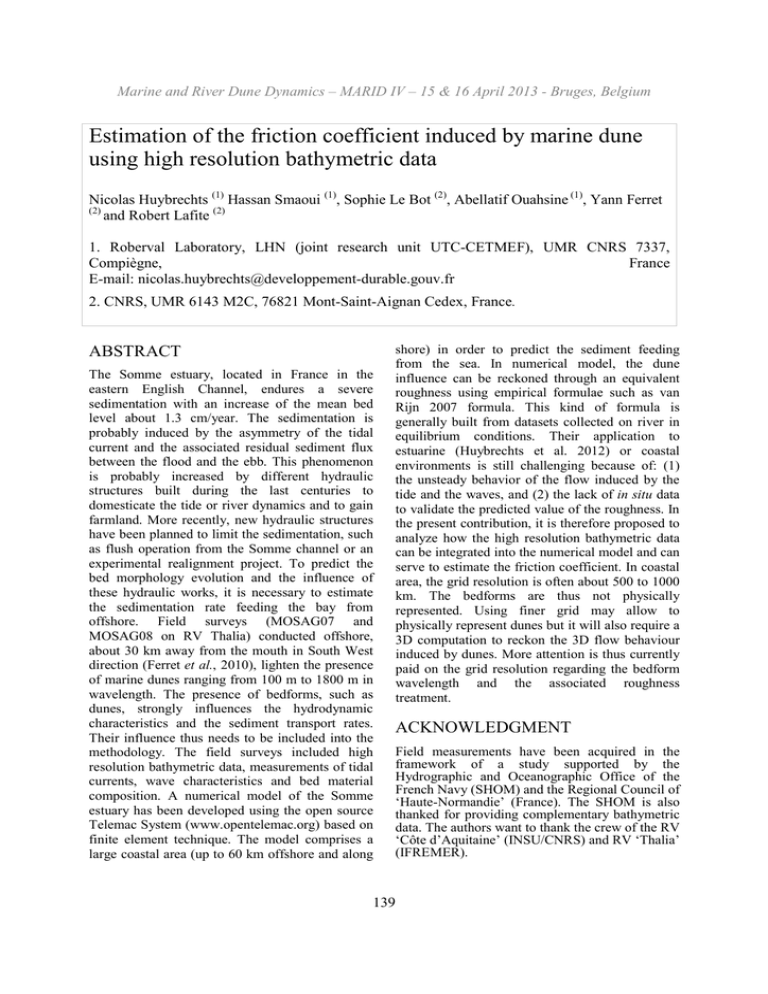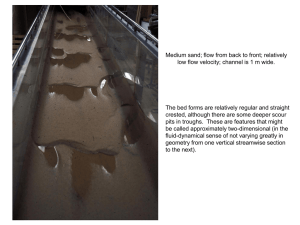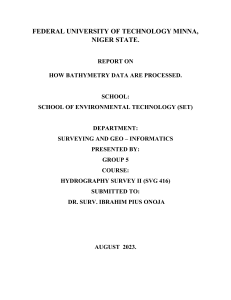Estimation of the friction coefficient induced by marine dune
advertisement

Marine and River Dune Dynamics – MARID IV – 15 & 16 April 2013 - Bruges, Belgium Estimation of the friction coefficient induced by marine dune using high resolution bathymetric data Nicolas Huybrechts (1) Hassan Smaoui (1), Sophie Le Bot (2), Abellatif Ouahsine (1), Yann Ferret (2) and Robert Lafite (2) 1. Roberval Laboratory, LHN (joint research unit UTC-CETMEF), UMR CNRS 7337, Compiègne, France E-mail: nicolas.huybrechts@developpement-durable.gouv.fr 2. CNRS, UMR 6143 M2C, 76821 Mont-Saint-Aignan Cedex, France. ABSTRACT The Somme estuary, located in France in the eastern English Channel, endures a severe sedimentation with an increase of the mean bed level about 1.3 cm/year. The sedimentation is probably induced by the asymmetry of the tidal current and the associated residual sediment flux between the flood and the ebb. This phenomenon is probably increased by different hydraulic structures built during the last centuries to domesticate the tide or river dynamics and to gain farmland. More recently, new hydraulic structures have been planned to limit the sedimentation, such as flush operation from the Somme channel or an experimental realignment project. To predict the bed morphology evolution and the influence of these hydraulic works, it is necessary to estimate the sedimentation rate feeding the bay from offshore. Field surveys (MOSAG07 and MOSAG08 on RV Thalia) conducted offshore, about 30 km away from the mouth in South West direction (Ferret et al., 2010), lighten the presence of marine dunes ranging from 100 m to 1800 m in wavelength. The presence of bedforms, such as dunes, strongly influences the hydrodynamic characteristics and the sediment transport rates. Their influence thus needs to be included into the methodology. The field surveys included high resolution bathymetric data, measurements of tidal currents, wave characteristics and bed material composition. A numerical model of the Somme estuary has been developed using the open source Telemac System (www.opentelemac.org) based on finite element technique. The model comprises a large coastal area (up to 60 km offshore and along shore) in order to predict the sediment feeding from the sea. In numerical model, the dune influence can be reckoned through an equivalent roughness using empirical formulae such as van Rijn 2007 formula. This kind of formula is generally built from datasets collected on river in equilibrium conditions. Their application to estuarine (Huybrechts et al. 2012) or coastal environments is still challenging because of: (1) the unsteady behavior of the flow induced by the tide and the waves, and (2) the lack of in situ data to validate the predicted value of the roughness. In the present contribution, it is therefore proposed to analyze how the high resolution bathymetric data can be integrated into the numerical model and can serve to estimate the friction coefficient. In coastal area, the grid resolution is often about 500 to 1000 km. The bedforms are thus not physically represented. Using finer grid may allow to physically represent dunes but it will also require a 3D computation to reckon the 3D flow behaviour induced by dunes. More attention is thus currently paid on the grid resolution regarding the bedform wavelength and the associated roughness treatment. ACKNOWLEDGMENT Field measurements have been acquired in the framework of a study supported by the Hydrographic and Oceanographic Office of the French Navy (SHOM) and the Regional Council of ‘Haute-Normandie’ (France). The SHOM is also thanked for providing complementary bathymetric data. The authors want to thank the crew of the RV ‘Côte d’Aquitaine’ (INSU/CNRS) and RV ‘Thalia’ (IFREMER). 139 Marine and River Dune Dynamics – MARID IV – 15 & 16 April 2013 - Bruges, Belgium REFERENCES Y. Ferret, S. Le Bot, B. Tessier, T. Garlan, R. Lafite (2010) "Migration and internal architecture of marine dunes in the eastern English Channel over 14 and 56 year intervals: the influence of tides and decennial storms" Earth Surface Processes and Landforms. Vol 35 Issue 12 pp 1480-1493 Huybrechts, N., Villaret, C. and Lyard, F. (2012) “Optimized predictive 2D hydrodynamic model of the Gironde estuary (France)”, Journal of Waterway, Port, Coastal and Ocean Engineering. Vol 138 (4) pp 312-322. van Rijn, L.C. (2007). “Unified view of sediment 140 transport by currents and waves. 1. Initiation of motion, bed roughness, and bed-load transport”, J. Hydraulic Eng. 133( 6), pp 649-667.






